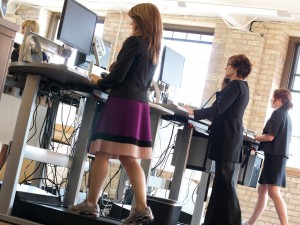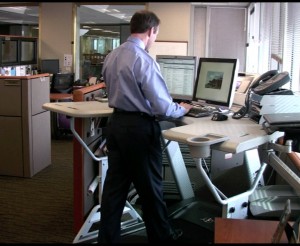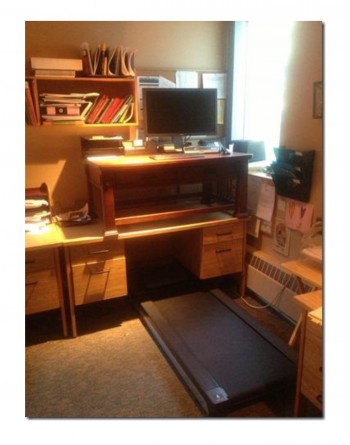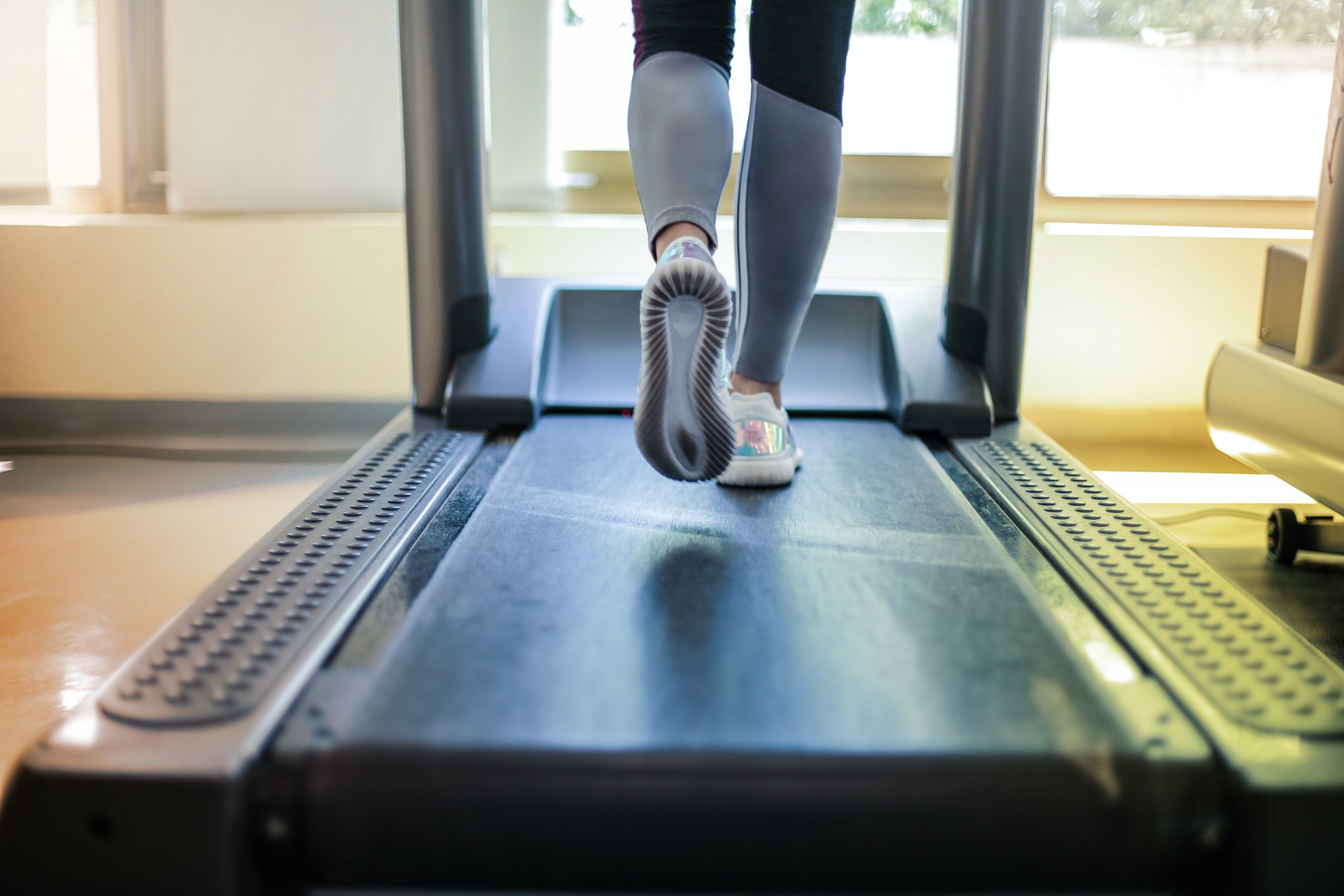
Are you sitting comfortably? Now brace yourself and you may want to stand because what comes next may surprise you. Sitting is making us humans sick, giving us pain, and literally killing us. In a typical day, Canadians are sitting at work, while commuting, at home and at social functions for example. Sitting is probably the most frequent position we are in. It is estimated that currently more than half of the workforce is sitting at computers and this is increasing.
What’s the issue?
Sedentary behavior is a large risk factor for poor health and early death. Sedentary is defined as any waking behavior that has a low energy expenditure such as sitting or reclining. There is a long list of proven health problems associated with a sedentary lifestyle:
- being overweight or obese
- heart and blood vessel disease
- back and neck pain, arthritis, and disc disease
- diabetes
- strokes and heart attacks
- reduced mental function and alertness
- and the list goes on……….
Sedentary lifestyle is a massive problem in our society. So what strategy can be used to address this widespread health issue? Of course as a physiotherapist I always work with patients to introduce exercise, activity and active living. But I often assume that this will be done in after work hours or performing it around a person’s travel schedule. There is a mind shift, however, occurring in North America where the time spent at work can be used to help a person’s health. Why not be active while working?
What can be done?
My friend Tom Gerstner, MD, was very enthusiastic when he told me about Dr. James Levine from the Mayo Clinic in Minnesota. More on Tom later. Dr. Levine is a major force behind the mind shift towards walking at work. He is the leading researcher of NEAT (Non-Exercise Activity Thermogenesis). This is the calories people burn doing everyday non-exercise activities such as sitting, standing, reaching for the remote control, or passing the debit card out the window at the fast food drive through. Sedentary workers have a low NEAT and overweight sedentary workers have an even lower NEAT.
Dr. Levine did a study published in the British Medical Journal in 2007. He studied obese people (Body mass index of 32 average) and he measured their energy usage in an office chair versus on a treadmill at a workstation at an average of 1.1 miles per hour (1.8 kilometres per hour). This is a slow walk as the average walking speed is 2.8 mph (4.5 kmh) to 3.4 mph (5.4 kmh).
What is a treadmill workstation or walk workstation? It is a treadmill set up so that a person can walk while at a computer, phone, and desk. See pictures below.


Dr. Levine wanted to develop a strategy that could allow people to expend energy and be active while being productive at a workstation. Other activity strategies in the workplace involve leaving the workstation such as stair climbing.
His conclusions were very encouraging and have made many major headlines over the last 6 years:
- The average sitting energy usage was 72 calories per hour whereas the energy usage while walking and working at 1.1 miles per hour (1.8 km/h) was 191 calories per hour. That’s 119 more calories per hour more or 265% more calories burned per hour than sitting.
- If the desk treadmill was used for half a workday that’s an extra 500 calories burned per day.
- Using these results Dr. Levine predicted that a person using the desk treadmill at 1.1 mph for 2-3 hours per day could lose up to 44 pounds ( 20kg) per year ! As long as everything else stayed the same in a person’s life such as diet and activity patterns.
- All the workers tolerated the workstation well and were able to perform all the standard computer functions.
- Dr. Levine said he hopes that one day his grandchildren are going to ask, “Was it really true that people had to sit and work?”
Benefits of the treadmill workstation:
The benefits go far beyond weight loss and weight control. One of the major factors causing back and neck pain is “static loading”. The other name for static loading is sitting or standing in one place. I am positive that walking at a workstation would drastically cut the levels of pain and disability due to back and spinal problems in Canada. The body is meant to be moving and it stays healthy with movement. Life is motion. To all you health professionals/researchers out there: this would make a great research study to confirm this hypothesis!
Tips on getting a treadmill workstation set up:
Winnipeggers and Manitobans are thrifty so here are some tips on getting set up with a treadmill workstation:
- My friend Tom Gerstner, who I mentioned earlier, told me about Dr. Levine’s research and how he was excited to incorporate a walking workstation at his office. He wanted to incorporate more activity into his lifestyle and improve his health. But like so many people it was a question of where to fit it in to his busy schedule. This concept seemed a perfect fit for him. He got set up for $1600 for the treadmill base and a makeshift desk. See picture below. He recommended this website to start shopping: www.lifespanfitness.ca. Prices can range up to $4000 for a desk and treadmill combination. A year later he is still enjoying his set up and his better health. Tom’s desk treadmill set up below:

- Another company has just the desks starting at $480: www.trekdesk.com
- The following company has products that allow a sit and stand combination through the day by the desk height adjusting and allowing a chair beside the treadmill. They cost $4500 including the treadmill: www.signaturetreadmilldesks.com/treadmill_desk_sit2stand.html
- For the more thrifty, perhaps set up a desk that can be used for sitting and standing. IKEA for example has some work tables with telescopic legs (Galant) that I believe are wide enough for both sitting and to have a treadmill next to a chair (bring a tape measure).
- Dr. Levine started himself on a Walk station regimen — 15 minutes at the top of every hour. Within six months, he got rid of his chair. “You simply get the hang of walking and working,” he said. “
- In regards to the idea of feeling alone with the set up: “Yes there’s peer pressure issues, but isn’t it better than the peer pressure of bringing donuts to work?” Dr. Levine said.
It is important to know that a walking workstation does not substitute for cardiovascular or strength exercise (sorry). It is meant to supplement an exercise program already in place. And of course it adds to the overall activity levels and health. In order to exercise the heart there has to be at a minimum of 20 minutes 3 days per week in the target heart rate zone. Also, in order to gain strength one need’s to perform resistance exercises. (see my Health Blog article “Exercise, Why Bother”).
Hopefully this article provided some motivation for change and it’s not too late for people to join the accelerating trend towards active living. Life is motion.




